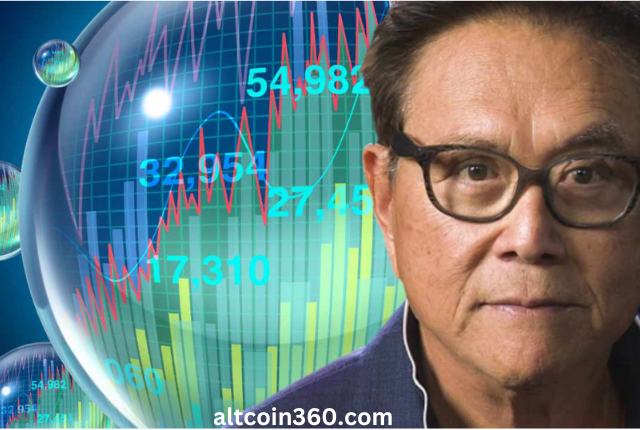Bitcoin Future Unveiled: A Mega Prediction by Rich Dad Author Foretells Digital Revolution, Mass Adoption, and Skyrocketing Value

Introduction
The world of cryptocurrencies has been a hot topic of discussion, speculation, and innovation in recent years. Bitcoin, the pioneer of the cryptocurrency movement, has garnered widespread attention from investors, technologists, and financial experts alike. One of the most intriguing predictions about Bitcoin’s future comes from none other than Robert Kiyosaki, the author of the bestselling book “Rich Dad Poor Dad.” Kiyosaki has long been an advocate for financial education and has made bold statements about Bitcoin’s future. In this article, we will explore Kiyosaki’s predictions and examine the factors that could drive Bitcoin’s digital revolution, mass adoption, and skyrocketing value.
Robert Kiyosaki’s Mega Prediction
Robert Kiyosaki is no stranger to making bold financial predictions. His book “Rich Dad Poor Dad” has sold over 40 million copies worldwide and has inspired countless individuals to take control of their financial future. Kiyosaki has been vocal about his belief in Bitcoin as a hedge against the traditional financial system’s instability.
Kiyosaki’s mega prediction revolves around Bitcoin becoming the “people’s money” and serving as a lifeline for individuals seeking financial freedom. He envisions a world where Bitcoin is widely adopted as a means of exchange, a store of value, and a form of investment. Kiyosaki predicts that as governments continue to print fiat currencies, devaluing them in the process, people will turn to Bitcoin to protect their wealth.
The Digital Revolution
To understand Kiyosaki’s prediction, it’s essential to recognize the ongoing digital revolution in the financial industry. Traditional financial systems have long been characterized by intermediaries, bureaucratic processes, and centralized control. Bitcoin, and blockchain technology in general, represents a shift towards decentralization, transparency, and security.
The digital revolution is not limited to Bitcoin alone. Central banks and governments worldwide are exploring the idea of digital currencies, often referred to as central bank digital currencies (CBDCs). These digital currencies could coexist with cryptocurrencies like Bitcoin or compete with them. However, the fundamental idea behind both Bitcoin and CBDCs is the digitization of money, which simplifies transactions, reduces costs, and increases financial inclusion.
Mass Adoption
Mass adoption of Bitcoin is a critical aspect of Kiyosaki’s prediction. For Bitcoin to become the “people’s money,” it must overcome several challenges, including scalability, regulatory hurdles, and public perception.
a. Scalability: Bitcoin’s scalability has been a long-debated issue. As more people and institutions adopt Bitcoin, the network must handle an increasing number of transactions. Solutions like the Lightning Network have been proposed to address this challenge and facilitate faster and cheaper transactions.
b. Regulatory Hurdles: Regulatory clarity is essential for mass adoption. Governments and regulatory bodies worldwide are still developing frameworks to govern cryptocurrencies. Clear and balanced regulations can provide the necessary legal infrastructure for Bitcoin’s growth.
c. Public Perception: The perception of Bitcoin has evolved over time. Initially viewed as a tool for illicit activities, it is now considered a legitimate investment and store of value by many. Public education and awareness campaigns will play a crucial role in changing perceptions and promoting adoption.
Skyrocketing Value
Bitcoin’s value has been a subject of fascination and controversy since its inception. Its price volatility has made headlines, attracting both speculators and long-term investors. Kiyosaki’s prediction of Bitcoin’s skyrocketing value is grounded in several factors.
a. Limited Supply: Bitcoin’s supply is capped at 21 million coins, creating scarcity similar to precious metals like gold. This limited supply has the potential to drive up its value as demand increases.
b. Institutional Adoption: Large institutional investors, such as hedge funds and corporations, are increasingly entering the cryptocurrency space. Their participation can lead to significant investments in Bitcoin, driving up its price.
c. Global Economic Uncertainty: Economic uncertainty, inflation, and currency devaluation in various countries have led people to seek alternative assets like Bitcoin to protect their wealth.
d. Network Effect: As more people and businesses use Bitcoin, its network effect strengthens, potentially increasing its value as a widely accepted means of exchange.
Challenges and Risks
While Kiyosaki’s prediction is optimistic, it’s crucial to acknowledge the challenges and risks associated with Bitcoin’s path to mass adoption and skyrocketing value.
a. Regulatory Risk: As mentioned earlier, regulatory uncertainty can pose a significant risk to Bitcoin’s growth. Excessive or restrictive regulations could stifle adoption and innovation.
b. Technological Challenges: Scalability and security remain ongoing challenges for blockchain networks. Solving these issues is essential for Bitcoin to fulfill its potential.
c. Market Volatility: Bitcoin’s price volatility can be a double-edged sword. While it attracts traders and investors, it can also deter some users from adopting it as a stable means of exchange.
d. Competition: Bitcoin faces competition from other cryptocurrencies and potentially from central bank digital currencies. Its ability to maintain its position as the dominant cryptocurrency is not guaranteed.
Conclusion
Robert Kiyosaki’s prediction of Bitcoin’s digital revolution, mass adoption, and skyrocketing value is a compelling vision of the future of finance. While it’s impossible to predict the exact trajectory of Bitcoin, its role in the global financial landscape is undoubtedly evolving. The digital revolution in finance, driven by technologies like blockchain, is reshaping how we think about money and transactions.
As Bitcoin continues to mature and overcome its challenges, it may indeed become a significant player in the financial world. Whether it achieves the level of mass adoption and value growth predicted by Kiyosaki will depend on a multitude of factors, including regulatory developments, technological advancements, and the collective choices of individuals and institutions.
Investors and enthusiasts should approach Bitcoin with a long-term perspective, acknowledging both its potential and the inherent risks associated with the cryptocurrency market. Regardless of the outcome, Bitcoin has already left an indelible mark on the financial industry and continues to inspire discussions about the future of money.




